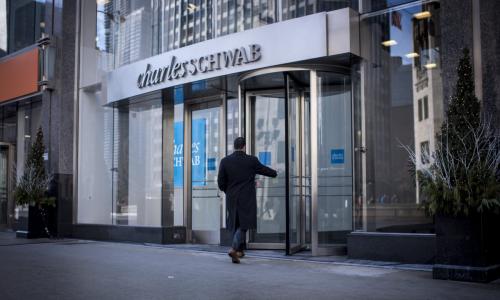There was a point before internet banking that passbooks were all the rage. These archaic devices were great. They were a constant running record of all of your transactions in an up to the minute format. From a tellers perspective they were horrible tedious accounts for old people. However they very much served a purpose. All of these new money market and high yield savings accounts didn’t exist. But, now they do. These new accounts from banks and credit unions and other (i.e. Sallie Mae Bank, Discover Bank) are far superior to most brick and mortar savings accounts. Below are FOUR reasons why:
1) Interest Rates (and all the fees)
First and foremost, people put money in a savings account for the interest. While some regional and local banks may offer high rates in an effort to get customers, this is not the norm. The norm is the mega banks, international behemoths with ATMs in 15 different languages. Let’s compare brick and mortar bank savings account rates vs. online bank rates. Note this is strictly for savings account rates.
Using the small subset of Wachovia/Wells Fargo and Chase for brick and mortar banks, the following are their rates. Readers, pay special attention to the stipulations and balance range.
Wachovia / Wells Fargo
High Yield Savings Account
Balance APY
$0.01 - $9,999.99 0.05%
$10,000 - $24,999.99 0.10%
$25,000 - $49.999.99 0.20%
$50,000 - $99,999.99 0.24%
$100,000 or more 0.30%
If this savings account is linked to a PMA® Prime Checking account, the APY of each bracket increases by 0.10%.
Chase
Basic Savings
Balance APY
$0.01 - ∞ (all balances) 0.01%
For this rate of one penny for every $100 per year savings account, unless one either maintains a minimum daily balance of $300; saver participates in the Automatic Savings Program, making at least one repeating automatic transfer of $25 or more from your Chase checking account each month; or saver is under 18 years old, there is a $4 monthly fee.
Chase
Plus Savings
Readers, note that a relationship rate when your account is linked to an active Chase Premier Plus Checking account or an active Chase Premier Platinum Checking account. Otherwise, non-relationship rates apply.
Balance APY (relationship) APY (non-relationship)
$0.01 - $9,999.99 0.10% 0.05%
$10,000 - $24,999.99 0.25% 0.10%
$25,000 - $49,999.99 0.50% 0.25%
$100,000 - $249,999.99 0.50% 0.25%
$250,000 - $499,999.99 0.75% 0.50%
$500,000 - $999,999.99 0.75% 0.50%
$1,000,000 - $4,999,999.99 0.75% 0.75%
$5,000,000+ 0.50% 0.50%
There is a monthly fee of $20 unless the fee when linked to Chase Premier Platinum Checking or Chase Premier Plus Checking or $15,000 minimum daily balance in this account.
Simply comparing the above rates to internet savings accounts like ING Direct (1.10% APY), Ally Bank (1.09%) and FBNO Direct Savings (1.10%) there must be some other reason to subjugate our money to subpar rates, right? These online banks (and others) do not charge a monthly fee and can be opened with a $1.
2) Access to Funds
Maybe it’s because access to savings accounts at brick and mortar banks serves as some resonation to a safe haven for one’s money. We assume our physical money is in some vault, safe from fire and theft and all things bad. Well, it’s not. The money is a stream of data saved on some server. Physically your dollar went to a loan for a house or car. It is not locked up; it is freely floating in this laissez faire economy. You and I and the government and the startup down the street are the forces behind the “invisible hand” Adam Smith prophesized.
There is often a fee to take the money directly from the savings account, unless one transfers the funds to a linked checking account. How is this different than an online savings account? Even these traditional banks offer online services, but pay lots more in overhead. That teller is expensive!
3) Safety Net (overdraft protection)
Possibly, one sets up a savings account for protection against themselves by way of overdraft protection. This is a legitimate reason if one’s checking account is linked directly to their savings account. However, for those who have been hit up with an overdraft fee, your $10 lunch somehow came to be $45. That $35 overdraft fee was a killer. Yet for those unaware, in August 2010, President Obama signed into law a law which requires customers opt in for overdraft protection. While one may become embarrassed for not having enough to pay for that sandwich, it is probably better they find out they don’t have enough to buy it at point of purchase, then being charged more money for the fact they don’t have money.
So, there is no need for a safety net of a savings account for overdraft unless your bank allows it and you, as the customer, consciously agree to the specifics of your overdraft procedure (and fees).
4) Customer Service
OK, so to briefly recap, there are more fees for account maintenance, lower interest rates, similar means of access (transferring monies to linked account – same or different bank matters little) and no need for use of an overdraft protection mechanism than internet banks. Then the difference must be customer service and the face to face relationships forged by going to a bank.
To digress, upon graduating from high school in Rhode Island, I was a teller for the summer before heading to Montreal for university. I was on the other side of that counter handling your transactions. I smiled and told you to “have a good day.” I also was trying to upsell you on a new product. CDs were at an astronomical 6% -8% and US I Bonds were a new novel product.
We had our regular customers and we knew the request. We had new customers and we greeted them warmly. It could possibly be due to the quaintness of the bank. I believe there were 10 branches. Maybe it was the small town vibe. Maybe it was just the atmosphere that was generated. Maybe it was the fact this was 10 years ago and a cell phone was a novelty.
I went to a bank in Salem, Massachusetts the other day needing to break a ten dollar bill for bus money to get to Boston. The stop was literally in front of a bank. Silly me, thinking how efficient that would be. I could make my $3.50 happen easily. I walked in and the teller was talking to another teller, who was texting. I asked if she could break my ten and she asked if I had an account. I said no. She responded by saying that for security reasons she could not make the exchange.
Readers, there is a lot I don’t do, but I especially don’t do yoga and stupid. Rather than taking the five seconds to rationalize that I was obviously coming from somewhere locally (this bank happened to be next to a college) and could potentially be future customer, she simply didn’t want to open her cash and break my bill. “Security” reasons was not the right term. Maybe “bank policy.” However, the beauty of speaking to someone is you can find out about them. In most environments there is a sale trying to happen. Even socially. This teller didn’t bother. She didn’t ask me anything, like, “Oh, you don’t have an account with us? Let me get you some information on what we have.” Noting I would have politely taken them, she should have broken my bill. Let’s call it quid pro quo.
It’s the simple things you remember. The nice gestures that stick. You also remember the petty, stupid gestures. This was one of them. Had this teller obliged me, I would have read the materials and determined if they had something to offer me. Now, they completely turned me away.
So much for customer service. With internet banks, you call a customer service number. Most are call centers with calls ‘recorded for quality and training purposes.’ They lack the ability to spite you, but are not given the opportunity. Also, remember the joke about banker’s hours? No joke, they work maybe 9 to 4 (As an 18 year old, I loved being off well before my friends. As an adult, this is frustrating). A selling pint is extended hours (the times everyone just gets off work). So, they are even less convenient.
Why would one give these banks their money to hold? Above are four reasons to change your mind.








Add your Comment
use your Google account
or use your BestCashCow account